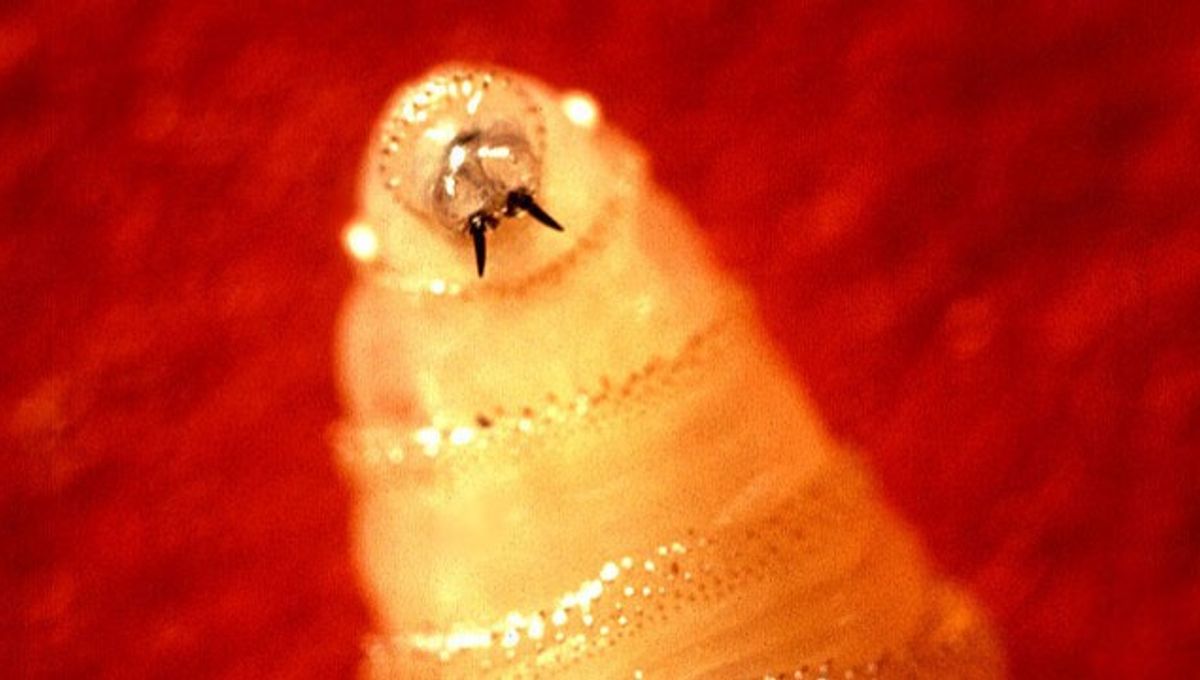
Waking up this morning, you may have seen the news that the US has reported its first human case of travel-associated New World screwworm – and most likely, along with the words “flesh eating parasite”. Those are some scary sounding words, but what exactly is New World screwworm, and how concerned do we really need to be?
What is New World screwworm?
New World screwworms (NWS) are the larvae of the New World screwworm fly (Cochliomyia hominivorax), dropped off into the wound of a living animal when they were still eggs.
The headlines that mention flesh eating aren’t wrong. After they hatch, the maggots begin burrowing their way deeper into the wound, feeding on the healthy flesh of the animal. They do so in a way that’s reminiscent of a screw being driven into wood – hence the name. This causes the initial wound to become larger and deeper, causing serious and potential deadly damage to the infested animal.
Infestations are most common in livestock, although, as recent news has reported, the NWS is also capable of feeding on humans. In this recent case, confirmed to Reuters by US Department of Health and Human Services (HHS) spokesperson Andrew G. Nixon, the affected patient had returned from travel to El Salvador, which is currently experiencing an outbreak of NWS.
Why are people concerned about it?
The reason why NWS has been hitting the headlines recently is because it appears to be on the brink of returning to the US, after a previous outbreak in Florida in 2016, and before then, having been successfully eliminated since the 1960s.
Back then, eradication was achieved using sterile dispersal programs, which began in 1957. This method involves releasing sterile male NWS flies into the wild, where they mate with wild females. No offspring are produced from this union, which gradually decreases the population. By using this method, the US had eradicated NWS by 1966.
Mexico also got rid of NWS in the 1970s – but now there’s been an outbreak there and in Central America. Infestations appear to be creeping their way northward, with a case of NWS having been reported less than 1,127 kilometers (700 miles) from the US border back in May, and then 595 kilometers (370 miles) away in early July.
Despite the recently reported human case of NWS, Nixon told Reuters that the “risk to public health in the United States from this introduction is very low.”
The biggest concern authorities in the US have right now is the potential effects of NWS on livestock, and as a result, food security. This is no small worry – think about how bird flu has affected the price of eggs. The USDA has reported that “NWS threatens over $100 billion in United States economic activity tied to the cattle and livestock industry alone.”
What’s being done about it?
After the report of the July NWS case near the border, Secretary of Agriculture Brooke Rollins declared that all southern border ports in the US would be closed to livestock trade. However, that’s blocking only one route by which the parasites could get into the country – they could make their way in on wildlife, for example. To stop the spread means officials are having to take a multi-pronged approach.
The USDA has been looking to the success of the 20th-century elimination program for inspiration. Back in June, for example, it was announced that Moore Air Base in Texas was being transformed into a sterile fly dispersal facility. Set to be completed at the end of this year, it could be used as a hub for dropping up to 100 million sterile flies per week in areas that need it.
Then, on August 15, Rollins announced that the airbase would also become home to what’s been dubbed a “fly factory” – a facility that it’s claimed will produce up to 300 million sterile flies every week. It’s set to work alongside similar facilities in Panama and Mexico, with the latter receiving $21 million in funding from the USDA for renovations that will see it produce an extra 60 to 100 million sterile flies.
Developing treatments for NWS is another important part of the plan, and on August 19, the Food and Drug Administration (FDA) reported that it had been given the authority by HHS to issue what’s known as Emergency Use Authorizations (EUAs) for drugs that are used to treat or prevent NWS infestations in animals.
You might’ve heard about EUAs during the COVID-19 pandemic, when the FDA issued one for the Pfizer/BioNTech vaccine. They’re typically used in situations that present an emerging and/or significant threat, and allow for drugs to be used that aren’t officially approved for treating or preventing NWS.
“Currently, there are no FDA-approved drugs for NWS in the United States. The FDA through an EUA can authorize the flexible, faster use of certain animal drug products that may be approved for other purposes, or available in other countries, but not formally approved for NWS in the U.S,” explained the FDA in a statement. “This ensures veterinarians, farmers, and animal health officials have timely access to the tools they need to protect pets, livestock, and the nation’s food supply.”
“This authorization equips FDA to act quickly, limit the spread of New World Screwworm, and protect America’s livestock,” added HHS Secretary Robert F. Kennedy, Jr.
Source Link: New World Screwworm: What Is It, And Why Is It Hitting The Headlines?